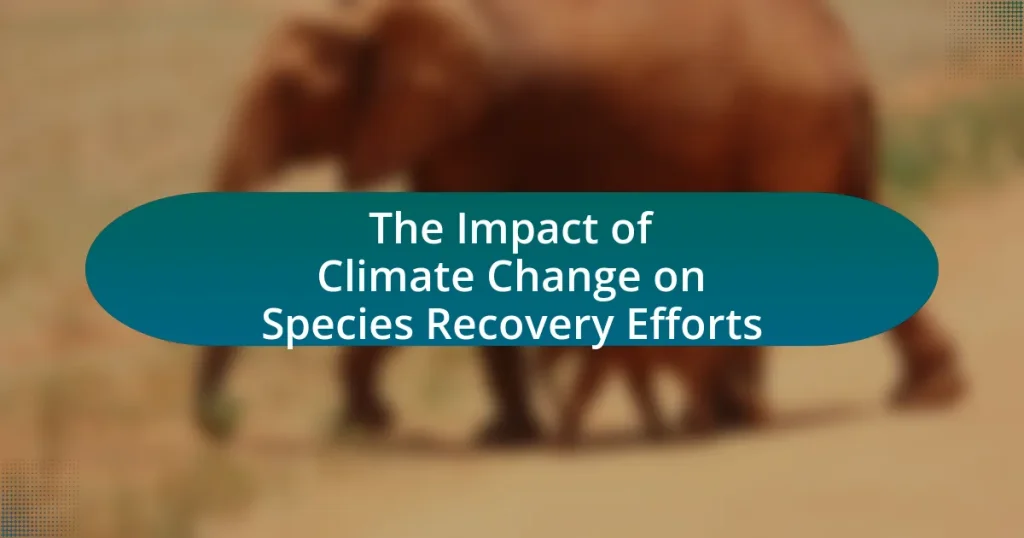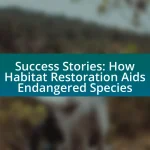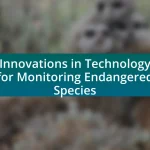The article examines the impact of climate change on species recovery efforts, highlighting how alterations in habitats, ecosystems, and increased extreme weather events hinder conservation strategies. It discusses the significant threats posed by rising temperatures, changing precipitation patterns, and habitat loss, which exacerbate existing challenges such as invasive species and diseases. The article emphasizes the critical role of recovery initiatives in maintaining biodiversity and ecosystem resilience, while also addressing the socio-economic implications and the importance of community involvement in conservation efforts. Key strategies for enhancing recovery in a changing climate, including adaptive management and collaboration among stakeholders, are also outlined.
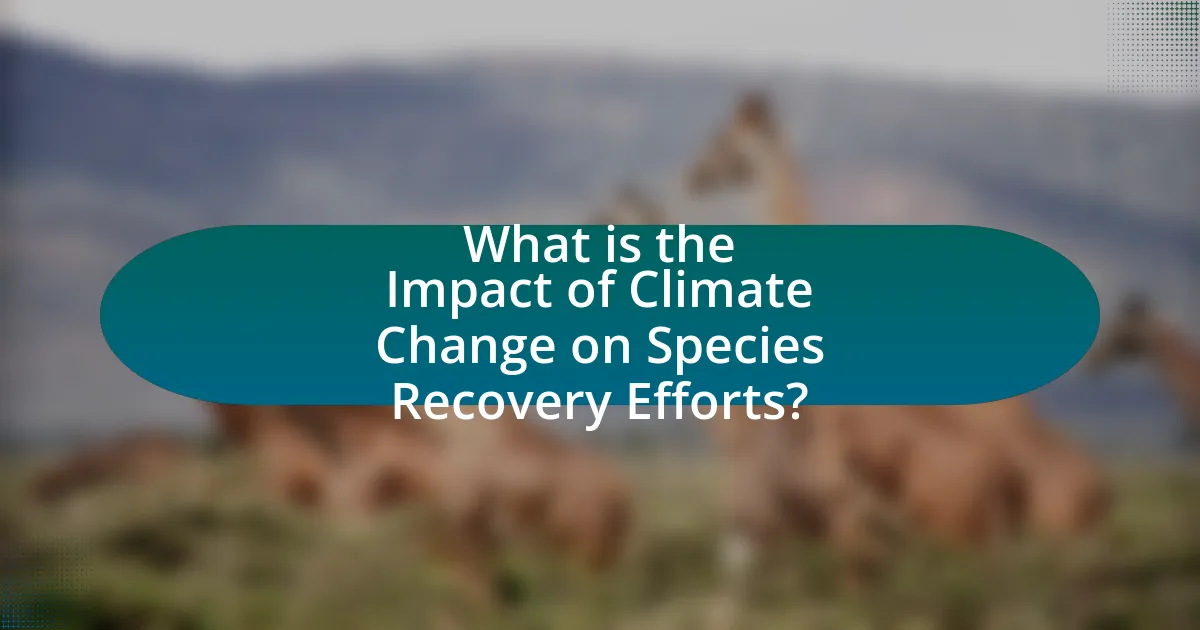
What is the Impact of Climate Change on Species Recovery Efforts?
Climate change significantly hinders species recovery efforts by altering habitats, disrupting ecosystems, and increasing the frequency of extreme weather events. For instance, rising temperatures and shifting precipitation patterns can lead to habitat loss, making it difficult for endangered species to find suitable environments for survival and reproduction. According to a study published in the journal “Nature Climate Change,” approximately 1 million species are at risk of extinction due to climate-related factors, which directly impacts conservation strategies aimed at recovery. Additionally, climate change can exacerbate existing threats such as invasive species and diseases, further complicating recovery initiatives.
How does climate change affect biodiversity and ecosystems?
Climate change significantly affects biodiversity and ecosystems by altering habitats, disrupting species interactions, and increasing extinction risks. Rising temperatures and changing precipitation patterns lead to habitat loss, as many species cannot adapt quickly enough to the new conditions. For instance, a study published in “Nature” by Thomas et al. (2004) estimated that 15-37% of species could face extinction if global temperatures rise by 2°C. Additionally, climate change can shift the distribution of species, leading to mismatches in predator-prey relationships and pollination processes, further destabilizing ecosystems. These changes threaten the resilience of ecosystems, making them less capable of recovering from disturbances.
What are the primary climate change factors influencing species recovery?
The primary climate change factors influencing species recovery include temperature changes, altered precipitation patterns, and increased frequency of extreme weather events. Temperature changes can affect species’ habitats and breeding cycles, leading to mismatches in food availability and reproductive timing. Altered precipitation patterns can disrupt water availability, impacting ecosystems and the species that rely on them. Increased frequency of extreme weather events, such as hurricanes and droughts, can cause habitat destruction and increase mortality rates among vulnerable species. These factors collectively hinder the ability of species to recover from population declines and adapt to changing environments.
How do changes in temperature and precipitation patterns impact species?
Changes in temperature and precipitation patterns significantly impact species by altering their habitats, food availability, and reproductive cycles. For instance, rising temperatures can lead to habitat loss for species that are unable to adapt quickly, while changes in precipitation can affect the water supply for plants and animals, disrupting ecosystems. Research indicates that a 1°C increase in temperature can shift species distributions by approximately 100 kilometers towards cooler areas, as documented in the study “Global Change and Biodiversity” by Sala et al. (2000). Additionally, altered precipitation patterns can lead to droughts or floods, which directly affect species survival rates and biodiversity.
Why are species recovery efforts critical in the context of climate change?
Species recovery efforts are critical in the context of climate change because they help maintain biodiversity and ecosystem resilience. Climate change poses significant threats to species through habitat loss, altered food availability, and increased competition, which can lead to extinction. For instance, the International Union for Conservation of Nature (IUCN) reports that climate change is a major driver behind the decline of over 1,000 species globally. By implementing recovery strategies, such as habitat restoration and protection, conservationists can mitigate these impacts, ensuring that species adapt to changing conditions and ecosystems remain functional.
What role do endangered species play in ecosystem health?
Endangered species play a crucial role in maintaining ecosystem health by contributing to biodiversity, which enhances ecosystem resilience and stability. Their presence helps regulate populations of other species, ensuring balanced food webs and nutrient cycling. For instance, the extinction of a keystone species, such as the sea otter, can lead to the overpopulation of sea urchins, which in turn devastates kelp forests, demonstrating the interconnectedness of species within ecosystems. Furthermore, endangered species often serve as indicators of environmental health; their decline can signal broader ecological issues, prompting conservation efforts that benefit entire ecosystems.
How do recovery efforts contribute to overall biodiversity resilience?
Recovery efforts enhance overall biodiversity resilience by restoring ecosystems and increasing species populations. These efforts, such as habitat restoration and species reintroduction, help to rebuild ecological networks that support diverse life forms. For instance, the reintroduction of wolves in Yellowstone National Park has led to increased biodiversity by regulating elk populations, which in turn allows vegetation to flourish and supports various other species. Furthermore, studies indicate that ecosystems with higher biodiversity are more resilient to climate change impacts, as they can better withstand disturbances and recover from environmental stressors. This interdependence highlights the critical role of recovery initiatives in fostering a robust and adaptable biodiversity framework.
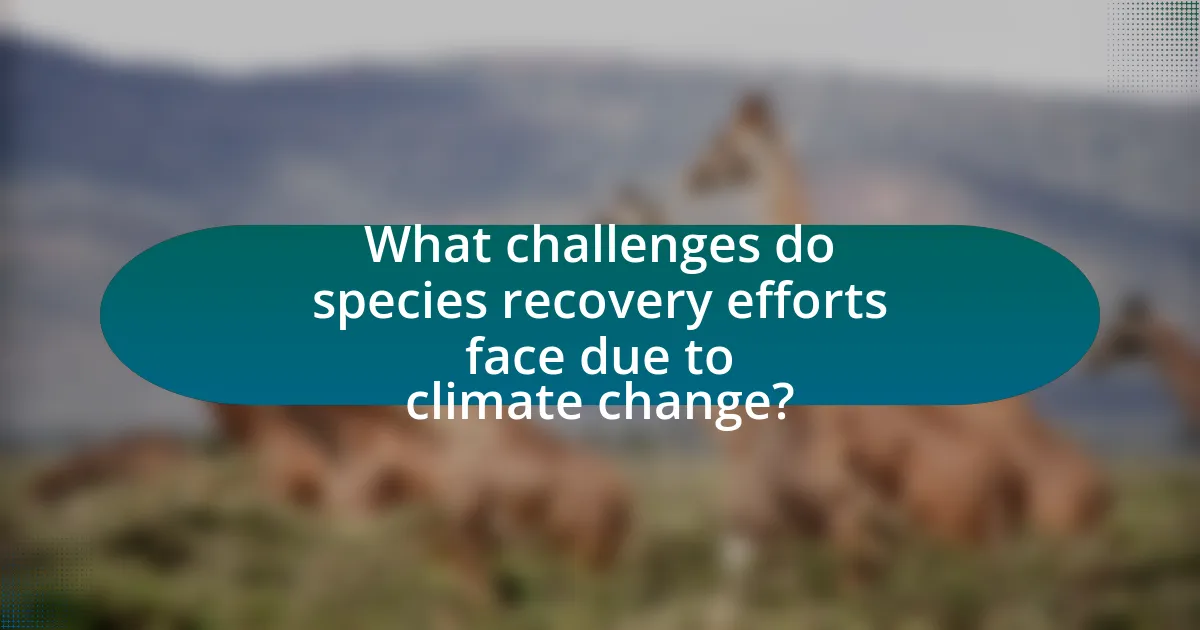
What challenges do species recovery efforts face due to climate change?
Species recovery efforts face significant challenges due to climate change, primarily through habitat loss, altered ecosystems, and shifting species distributions. Climate change leads to rising temperatures and changing precipitation patterns, which can degrade or eliminate critical habitats necessary for the survival of endangered species. For instance, the Intergovernmental Panel on Climate Change (IPCC) reports that many species are experiencing range shifts, moving towards cooler areas or higher altitudes, which can disrupt existing ecosystems and complicate recovery strategies. Additionally, climate change can exacerbate the effects of other stressors, such as pollution and invasive species, further hindering recovery efforts. These challenges necessitate adaptive management strategies that consider the dynamic nature of ecosystems influenced by climate change.
How does habitat loss impact recovery initiatives?
Habitat loss significantly hinders recovery initiatives by reducing the available space and resources necessary for species to thrive. When natural habitats are destroyed or fragmented, the remaining areas may not support the ecological needs of the species targeted for recovery, leading to decreased population viability. For instance, a study published in the journal “Ecological Applications” found that habitat degradation can lead to a 50% decline in species recovery success rates, as it limits their access to food, shelter, and breeding sites. This evidence underscores the critical role that intact habitats play in the effectiveness of recovery efforts, highlighting that without adequate habitat, species may struggle to rebound from threats such as climate change.
What are the consequences of shifting habitats on species survival?
Shifting habitats due to climate change significantly threaten species survival by disrupting ecosystems and altering species interactions. As habitats change, many species face challenges such as loss of food sources, increased competition, and difficulty in finding suitable breeding grounds. For instance, a study published in “Nature Climate Change” by Parmesan and Yohe (2003) found that 50% of species studied in various ecosystems are already experiencing shifts in their geographic ranges due to climate change. This displacement can lead to population declines and increased extinction risks, particularly for species with limited mobility or specialized habitat requirements.
How do invasive species complicate recovery efforts?
Invasive species complicate recovery efforts by outcompeting native species for resources, disrupting ecosystems, and altering habitat conditions. For instance, invasive plants can dominate landscapes, reducing the availability of sunlight and nutrients for native flora, which hinders their growth and reproduction. Additionally, invasive predators can decimate populations of native species, leading to further declines and potential extinction. Research indicates that invasive species are responsible for approximately 42% of the species listed as endangered in the United States, highlighting their significant impact on biodiversity and recovery initiatives.
What are the socio-economic implications of climate change on recovery efforts?
Climate change significantly hampers recovery efforts by exacerbating socio-economic disparities and increasing resource scarcity. As climate-related events like droughts and floods become more frequent, vulnerable communities face heightened risks, leading to increased poverty and reduced access to essential services. For instance, the World Bank estimates that climate change could push over 100 million people into extreme poverty by 2030, undermining recovery initiatives aimed at restoring ecosystems and species. Additionally, economic losses from climate impacts can divert funding away from conservation efforts, further complicating recovery strategies for endangered species.
How do local communities influence species recovery strategies?
Local communities significantly influence species recovery strategies by providing local knowledge, engaging in conservation efforts, and advocating for policies that support biodiversity. Their understanding of local ecosystems allows for tailored recovery plans that consider specific environmental conditions and species needs. For instance, community-led initiatives, such as habitat restoration projects, have been shown to enhance the effectiveness of recovery strategies, as evidenced by the success of the community-based conservation model in the recovery of the California condor, where local involvement was crucial in breeding and release programs. Additionally, local communities often serve as stewards of their environments, monitoring species populations and reporting changes, which is vital for adaptive management in response to climate change impacts.
What funding challenges arise in the face of climate change?
Funding challenges arising in the face of climate change include limited financial resources, competing priorities, and the unpredictability of climate impacts. Limited financial resources hinder the ability of organizations to implement effective climate adaptation and mitigation strategies, as evidenced by a report from the Global Environment Facility, which states that funding for climate-related projects is often insufficient to meet the growing demands. Competing priorities among governments and private sectors can divert attention and resources away from climate initiatives, leading to inadequate support for species recovery efforts. Additionally, the unpredictability of climate impacts complicates long-term funding commitments, as stakeholders may be hesitant to invest in projects with uncertain outcomes.
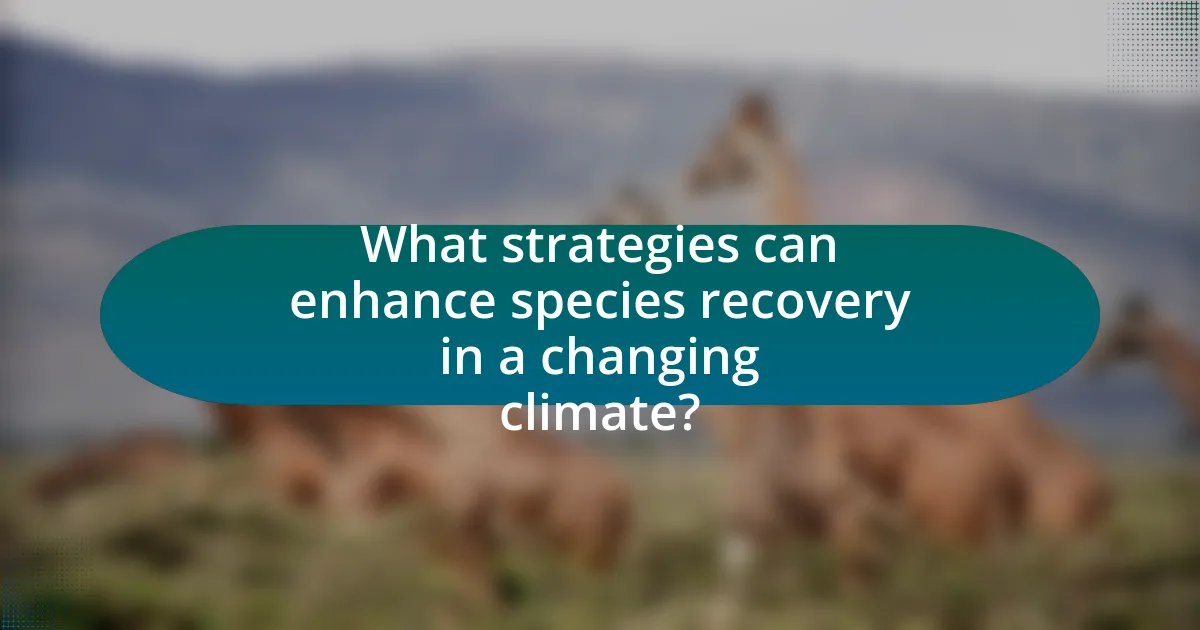
What strategies can enhance species recovery in a changing climate?
Strategies that can enhance species recovery in a changing climate include habitat restoration, assisted migration, and genetic management. Habitat restoration involves rehabilitating ecosystems to support native species, which has been shown to improve biodiversity and resilience against climate impacts. Assisted migration refers to relocating species to more suitable habitats as their current environments become inhospitable, a strategy supported by studies indicating successful establishment in new areas. Genetic management focuses on maintaining genetic diversity within populations, which is crucial for adaptability; research has demonstrated that genetically diverse populations are more resilient to environmental changes. These strategies collectively contribute to effective species recovery in the face of climate change.
How can adaptive management improve recovery outcomes?
Adaptive management can improve recovery outcomes by allowing for flexible decision-making based on ongoing monitoring and evaluation of ecological conditions. This approach enables managers to adjust strategies in response to new information or changing environmental factors, which is crucial in the context of climate change where conditions can rapidly evolve. For instance, a study published in the journal “Ecological Applications” by Williams et al. (2011) demonstrated that adaptive management practices led to more effective conservation strategies for endangered species by incorporating real-time data and stakeholder feedback, ultimately enhancing recovery success rates.
What are the key principles of adaptive management in conservation?
The key principles of adaptive management in conservation include a systematic approach to decision-making that emphasizes learning and flexibility. This approach involves setting clear objectives, monitoring outcomes, and adjusting management strategies based on what is learned from the results. For instance, the U.S. Fish and Wildlife Service employs adaptive management to enhance the recovery of endangered species by integrating scientific research and stakeholder input, allowing for modifications in conservation practices as new data emerges. This iterative process ensures that conservation efforts remain effective in the face of changing environmental conditions, such as those brought on by climate change.
How can monitoring and evaluation inform recovery strategies?
Monitoring and evaluation can inform recovery strategies by providing data-driven insights that guide decision-making and resource allocation. These processes enable the assessment of species population trends, habitat conditions, and the effectiveness of implemented recovery actions. For instance, the IUCN Red List assessments utilize monitoring data to evaluate species’ conservation status, which directly influences recovery planning. Furthermore, studies have shown that adaptive management, which relies on continuous monitoring and evaluation, leads to more effective recovery outcomes by allowing for timely adjustments based on observed results. This evidence underscores the critical role of systematic monitoring and evaluation in enhancing the success of recovery strategies in the context of climate change impacts on species.
What role does collaboration play in successful recovery efforts?
Collaboration is essential for successful recovery efforts as it enhances resource sharing, knowledge exchange, and coordinated actions among stakeholders. Effective collaboration among government agencies, non-profit organizations, and local communities leads to more comprehensive strategies that address the multifaceted challenges posed by climate change on species recovery. For instance, the U.S. Fish and Wildlife Service emphasizes that partnerships with various stakeholders have resulted in improved habitat restoration and species monitoring, which are critical for adapting recovery plans to changing environmental conditions. This collaborative approach not only increases the efficiency of recovery initiatives but also fosters community engagement and support, which are vital for long-term success.
How can partnerships between organizations enhance recovery initiatives?
Partnerships between organizations can enhance recovery initiatives by pooling resources, expertise, and data, which leads to more effective strategies for addressing challenges. Collaborative efforts allow organizations to share best practices and innovative solutions, increasing the overall impact of recovery initiatives. For instance, the partnership between the U.S. Fish and Wildlife Service and various conservation groups has resulted in successful recovery plans for endangered species, demonstrating that combined efforts can yield better outcomes than isolated actions. This collaborative approach is essential in the context of climate change, where multifaceted challenges require diverse skill sets and knowledge bases to develop comprehensive recovery strategies.
What are the benefits of community involvement in recovery projects?
Community involvement in recovery projects enhances the effectiveness and sustainability of these initiatives. Engaging local populations fosters a sense of ownership and responsibility, which can lead to increased participation and support for conservation efforts. Research indicates that projects with community involvement often see higher success rates; for example, a study published in the journal “Conservation Biology” found that community-led conservation initiatives resulted in a 50% increase in biodiversity outcomes compared to top-down approaches. Additionally, local knowledge contributes valuable insights into species behavior and habitat needs, improving recovery strategies. Overall, community involvement not only strengthens recovery efforts but also builds resilience against challenges posed by climate change.
What practical steps can be taken to support species recovery in the face of climate change?
Practical steps to support species recovery in the face of climate change include habitat restoration, legal protection, and adaptive management strategies. Habitat restoration involves rehabilitating ecosystems to improve conditions for species survival, as demonstrated by the successful restoration of wetlands that support diverse wildlife. Legal protection, such as the Endangered Species Act in the United States, provides a framework for conserving threatened species and their habitats. Adaptive management strategies, which involve monitoring species responses to climate changes and adjusting conservation efforts accordingly, have been shown to enhance resilience in species populations. For instance, studies indicate that adaptive management can significantly improve the recovery rates of endangered species by allowing for timely interventions based on ecological data.
How can individuals contribute to local conservation efforts?
Individuals can contribute to local conservation efforts by participating in community clean-up events, supporting local conservation organizations, and advocating for sustainable practices. Engaging in clean-up activities helps remove litter and pollutants from natural habitats, directly benefiting local ecosystems. Supporting organizations like the Nature Conservancy or local wildlife groups can provide essential funding and volunteer manpower for conservation projects. Advocacy for sustainable practices, such as reducing plastic use or promoting native plant gardening, fosters a culture of environmental stewardship. Research indicates that community involvement in conservation can lead to improved biodiversity and ecosystem health, as seen in various successful local initiatives across the globe.
What best practices should organizations adopt for effective recovery planning?
Organizations should adopt a comprehensive approach to recovery planning that includes risk assessment, stakeholder engagement, and adaptive management. Conducting a thorough risk assessment allows organizations to identify vulnerabilities related to climate change impacts on species, ensuring that recovery strategies are tailored to specific threats. Engaging stakeholders, including local communities and conservation experts, fosters collaboration and enhances the effectiveness of recovery efforts. Implementing adaptive management practices enables organizations to adjust strategies based on monitoring results and changing environmental conditions, which is crucial in the context of climate change. These best practices are supported by studies indicating that inclusive and flexible recovery plans significantly improve outcomes for endangered species in shifting ecosystems.
